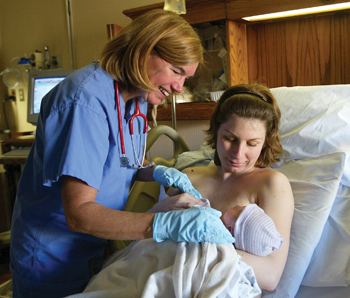
Bette Moore, Ph.D., a researcher in the School of Nursing and lactation consultant at VUMC, helps new mother Wendy Vermeulen Clarke as she begins to breastfeed her newborn son, Aiden.
photo by John Russell
Close contact spurs breastfeeding: study

Wendy and Fred Clarke share a moment with their newborn son Aiden in the labor and delivery unit of VUMC.
photo by John Russell
A researcher in the Vanderbilt University School of Nursing has discovered that skin-to-skin contact between mother and newborn immediately following birth can help babies more successfully begin breastfeeding.
Bette Moore, who recently earned her Ph.D. at VUSN and is a lactation consultant at Vanderbilt University Medical Center, studied a small group of women in the Labor and Delivery Unit at VUMC over a period of six to nine months. Typically, Moore said newborns might be skin to skin only for a few minutes after delivery, but are quickly moved to a baby warmer in the delivery room for a few minutes of necessary treatment and cleaning, then swaddled in a blanket to keep warm and handed back to the mother. Moore's study tried something different.
“I thought maybe if we let babies be skin to skin and they got extra tactile, thermal and olfactory cues, that maybe this would assist them to establish more effective breastfeeding,” said Moore.
Half of the women in her study received their babies in the standard manner and half were handed their babies immediately following delivery for close contact. “Babies who were placed skin to skin nursed more effectively than those we had swaddled, and it took about half the time to learn to feed consistently and competently than babies held swaddled,” said Moore.
She said she sees the method as getting back to basics. “Mothers and babies have been biologically programmed to be together. We assume placing them in the warmer and separating them is the normal thing to do, but in reality the technology needs to be evaluated. The norm, really for mothers and babies, is to be together,” said Moore.
She said there are some drawbacks, however, mostly due to the busy business of delivering babies. “It takes awhile for babies to latch on and start suckling. The babies are placed on the mother's chest and begin to make hunger signals and crawl toward the breast. It could take up to 45 minutes post-birth,” admits Moore. “There are so many patients and so little time,” she added.
Whatever method is used to initiate breastfeeding, Moore said it's no secret that the practice is good for both mother and baby. Breast milk contains antibodies to help protect infants from bacteria and viruses and to help them fight off infection and disease. Moore said a mother's milk has just the right combination of fat, sugar, water and protein needed for a baby's development, and most have an easier time digesting breast milk than they do formula.
Aside from helping a mother bond with her baby, breastfeeding also uses up extra calories, making it easier to lose pounds gained during pregnancy. Moore said it also helps the uterus return to its original size faster, and she added that breastfeeding may also lower the risk of breast and ovarian cancers.
Statistics show women are starting to get the message and are initiating breastfeeding after delivery. A national survey of breastfeeding women in the United States conducted in 2001 shows more than two-thirds of the children had been breastfed. The numbers are near the national Healthy People 2010 goal of 75 percent, but the rates of breastfeeding duration at six and 12 months postpartum are still considerably below the national goals of 50 percent and 25 percent, respectively.
Moore said she has presented her work to an international group of lactation consultants and hopes the skin-to-skin contact method will begin to be used more often by mothers who decide to breastfeed.













